The Darkness Shall Become Like the Noonday.
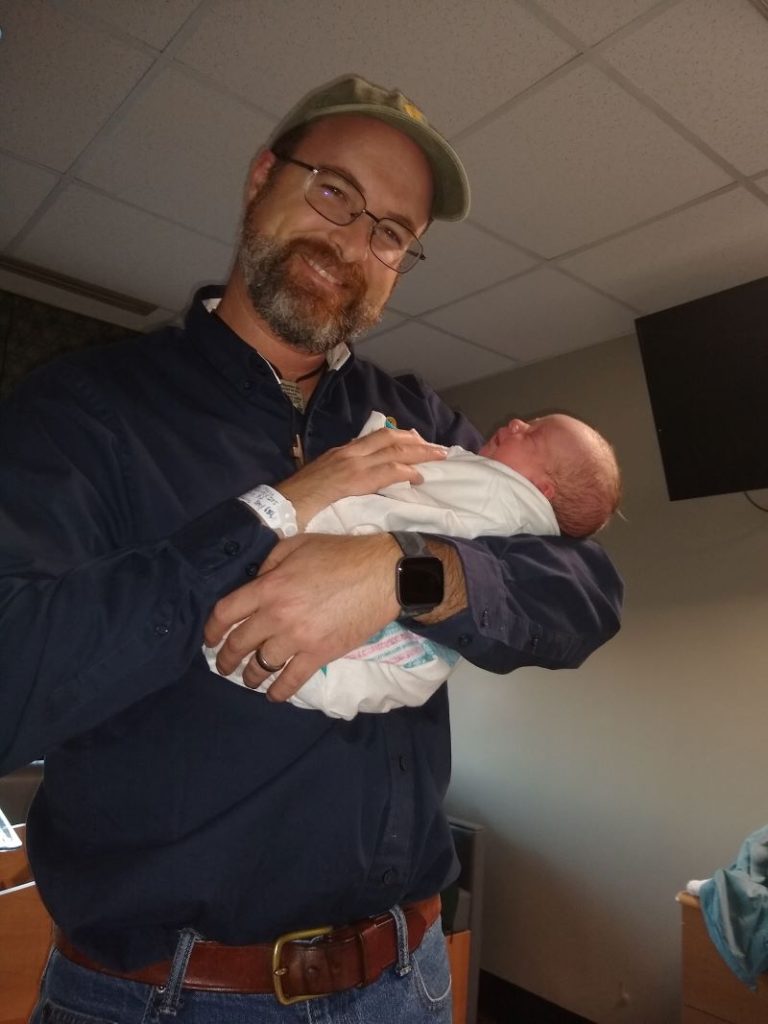
Holding my newborn baby girl puts things in perspective. Her name is Veronica Rose. The name Veronica means “image of truth”.
Why am I building this addition? So this little girl will have a place to live and grow and learn to love God and neighbor. So she can flourish and discover who God created her to be. To provide a place where her mother and sister and brothers can experience family life that nourishes them physically, intellectually, emotionally, and spiritually.
That’s a pretty tall order. Especially given the amount of construction experience I have. Without God’s help, I think that it would be impossible.
But with God, all things are possible.
Hitting the Wall.
But I missed my deadline. When I found out that Mary was pregnant, I wrote that I wanted to get the addition done before the baby was born. That hasn’t happened. I pretty much knew that it wasn’t going to happen about a month ago.
After finishing the rough-in inspection, Larry told me, “Congratulations. You’re halfway done.” I laughed and thanked him. I half believed him, but any doubt has now vanished. I think Mary knew before I did. She mentioned a few times that she wasn’t terribly concerned about the deadline. I would finish it when I finished it. That eased some of the pressure I was putting on myself to GET IT DONE.
I said at the beginning of this project that it would be a marathon, not a sprint. Running an actual marathon doesn’t seem to be in my future. Maybe because I don’t like running. I also don’t think that I’ll be able to train a bear to chase me for 26 miles. That’s probably what it would take.
I’ve always heard that marathon runners experience something they call, “The Wall.” The wall is the point where your body just doesn’t want to go any further. Continuing to run after you hit the wall is an act of pure will.
My wall was drywall.
Why is drywall so hard? It’s nothing in particular. In fact, several people that I talked to pointed out that a veteran drywall crew could finish the job in less than a week. But I am NOT a veteran drywall crew. And, while I did have some help, I did a lot of it on my own.
Hanging Out.
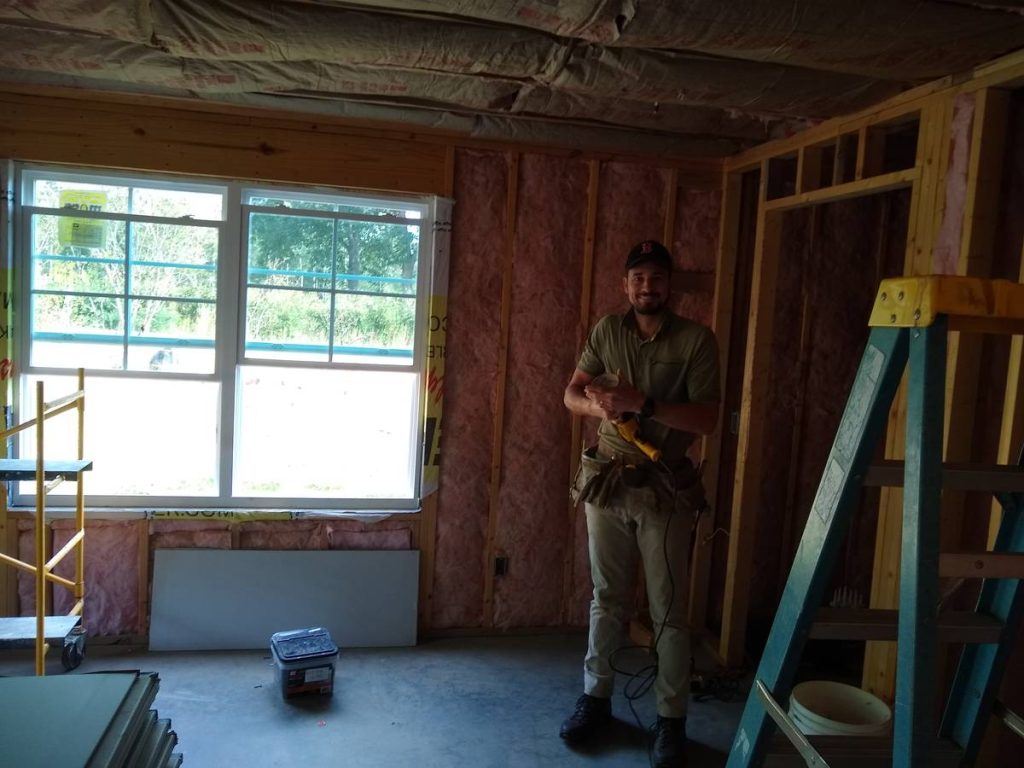
On the first day of drywall, my good friend and neighbor Tom Molitor came to join me. He confessed that he had about as much experience hanging drywall as I did. But he’s a doctor, so he’s a pretty smart guy, and he also worked in construction at one point before getting his MD.
How hard can hanging drywall be? Well, we started in the master bedroom, and the first thing we had to do was figure out where the lights were going to be placed. This took a consultation with my wife and no little bit of debate. After about an hour of standing around talking, we were ready to hang the first 12-foot sheet of drywall.
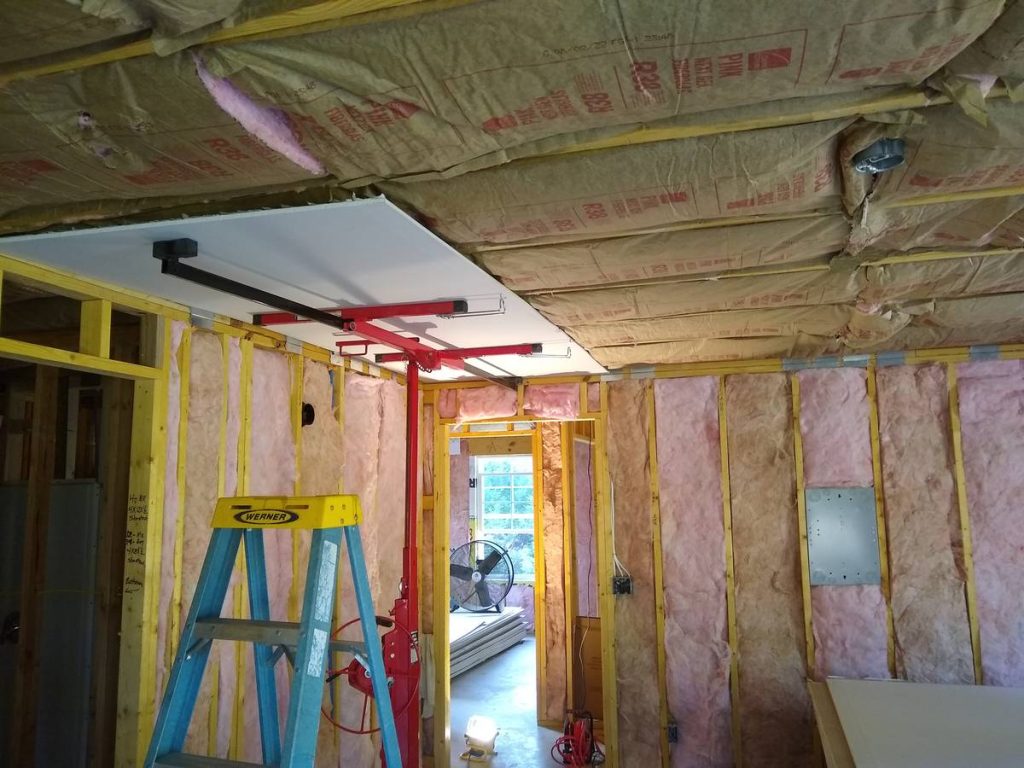
Larry borrowed a drywall lift from a friend of his, which made this process a lot easier. A drywall lift (that red thing in the picture) has a rack for holding drywall and a crank for lifting it into place. I don’t think we could have done this job without it. The challenge with hanging drywall on the ceiling is that the paper that holds a piece of drywall together isn’t particularly strong. The weight of the drywall will pull a single screw right through. So, you have to hold it in place until you can get enough screws over a large enough area that the whole sheet won’t fall down on top of you.
The drywall lift made that much easier. Put it on the lift, crank it up, and put a bunch of screws into the rafters. Sounds so easy, right?
Unfortunately, we were both newbies and slow. By the time lunch rolled around, we had almost finished the ceiling in the Master bedroom. That’s when Larry showed up. “You did that wrong.” What? Of course, he was right, but what was the problem?
The problem came from the seams between the sheets, also called joints. The long edge of a piece of drywall has a slight taper that makes room for mud and tape during the finishing process. That makes creating a smooth finish easier. The short end, called the butt, doesn’t have that taper, so the seams at butt joints are harder to make perfectly smooth. When hanging a ceiling, you’re supposed to stagger the butt joints to make it easier to conceal. Now I know. We didn’t do that. We had a line of butt joints all the way across. “You’ll never be able to cover that up. It’s going to pull your eye to it.”
What could I do? I decided to leave it in place. The drywall in the main house has some ugly seams. If I can’t get the ceiling in my new bedroom perfect, then it will match the rest of the house. I just didn’t want to redo 3 hours of work.
Fast and Slow.
Larry does know what he’s doing, so even though Tom had to leave shortly after Larry arrived, we were able to get more work done fairly quickly. With three guys, putting up the walls in the master bedroom went pretty quickly. Tom and Larry worked on cutting out the holes for the electric outlets while I put in hundreds of drywall screws. By the time Tom quit for the day, we’d made more progress.
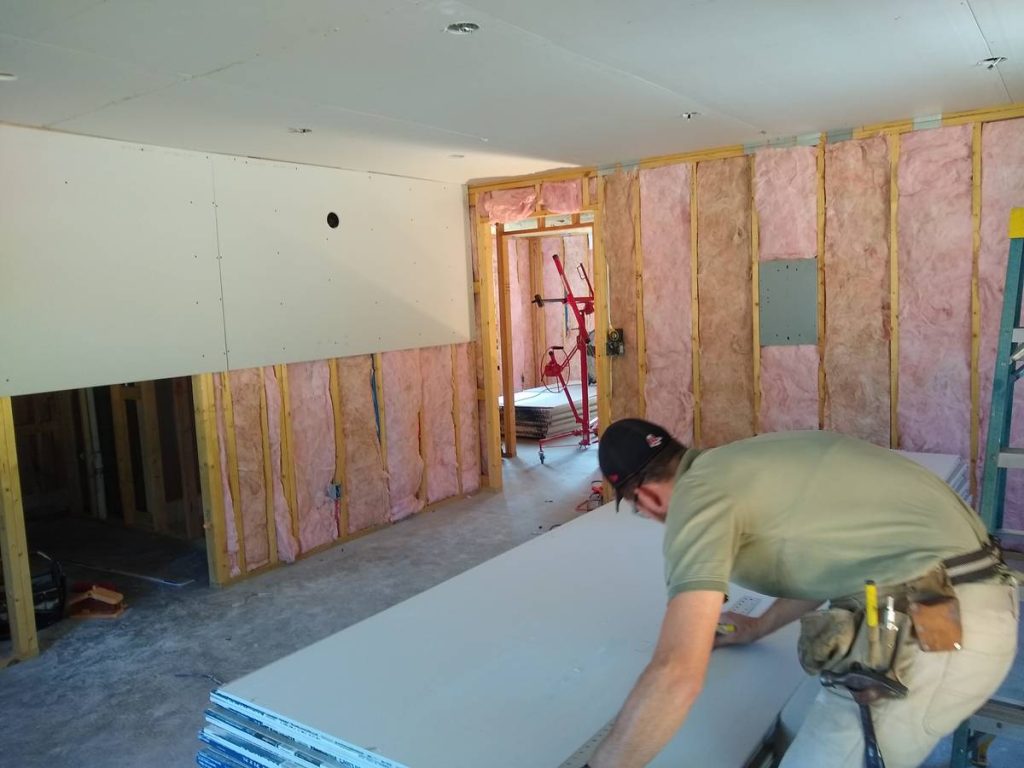
After lunch, Larry and I kept going. You might notice from the picture above that we didn’t cut the holes for the doors (or the windows) until after each sheet was hung. There’s a good reason for that, which I would learn later. Fewer seams mean less taping, bedding, and finishing. That’s a very good thing. That’s also why we used 12 ft sheets instead of 8 ft sheets wherever possible.
After hanging full sheets over the doors and windows, Larry or I would cut out the hole with a drywall saw. I have learned to love drywall saws. Drywall saws have a sharp point that you can wiggle right through a piece of drywall to start a cut for a switch or fixture. What a genius design!
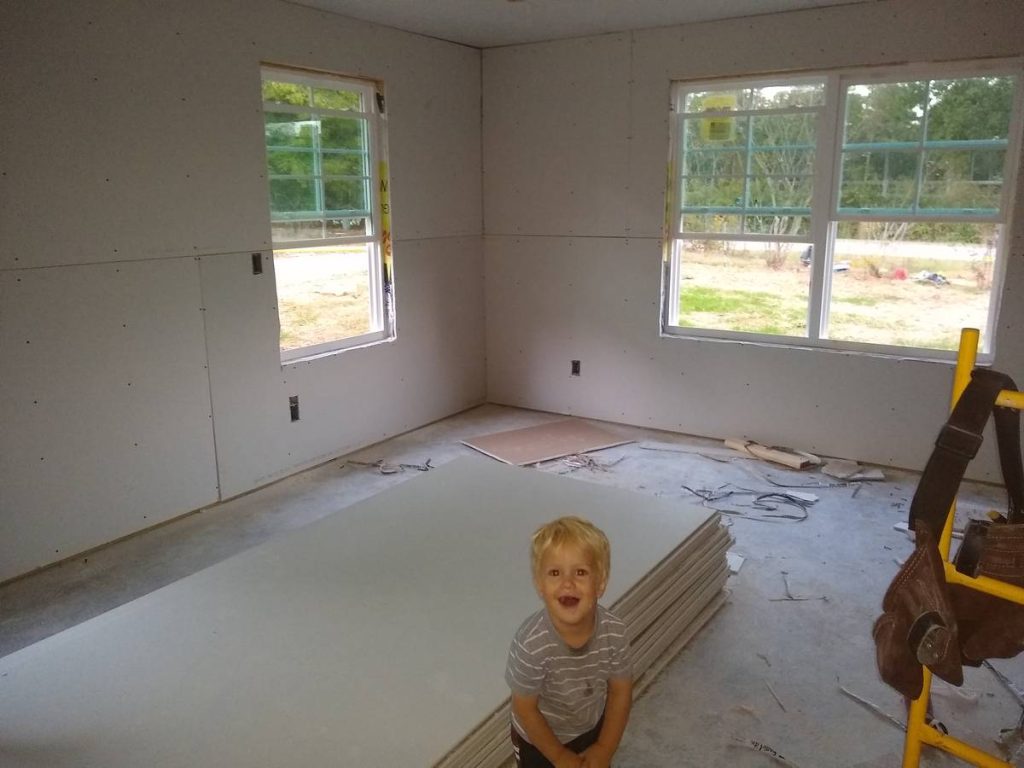
The first full day ended with one room almost done. That only left two more bedrooms, one hallway, two bathrooms, and four closets. This was going to take a while.
At the end of the day, I discovered that drywall has one unexpected hazard. Splinters. I’m sure you’re thinking, “Don’t splinters come from wood?” Some, and maybe even most, splinters come from wood, and I got some doozies while framing the house. But I’m not talking about wooden splinters.
I’m talking about metal splinters from drywall screws. It took about 4,500 drywall screws to hang all the drywall in the addition. And a screw will sometimes leave a little fiber of steel in your fingertips. I had three or four at the end of my first day and dozens by the end of this phase of the project. Super fun.
Making a break for it.
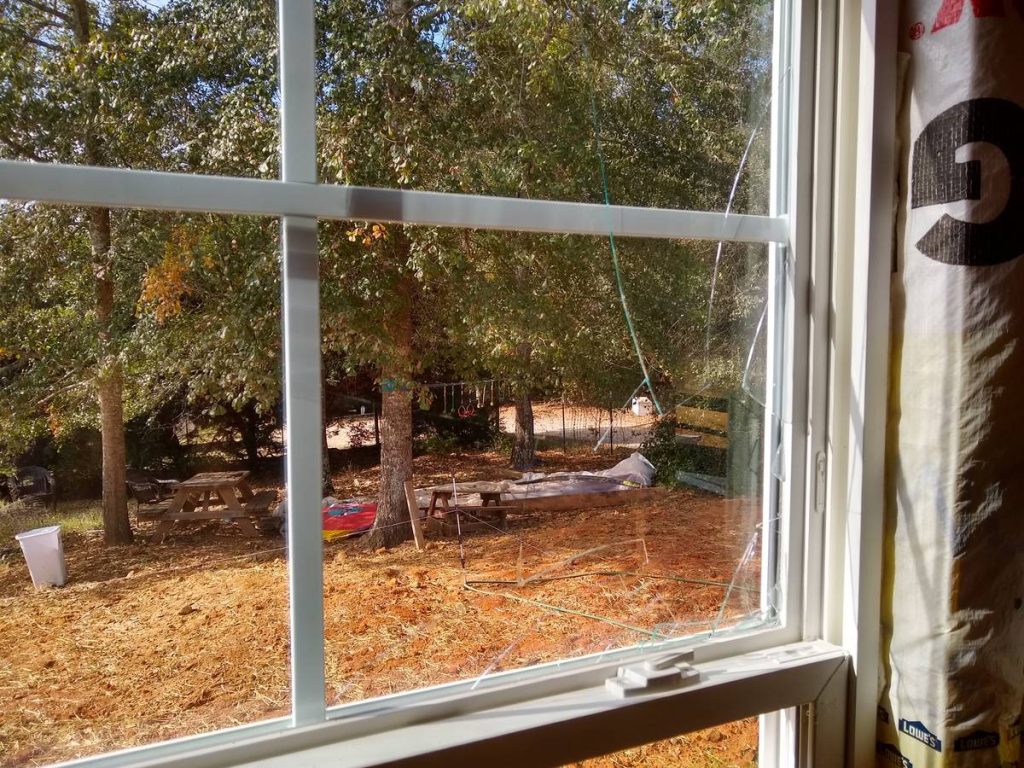
The drywall lift makes it possible for one person to install drywall. In theory. Larry said that he used a lift like that to do all the drywall in his current home by himself. I am not Larry. Larry has years of experience and construction wisdom. I don’t have either of those things. But I do have a continual need to grow in humility, which is why I keep doing things that are probably harder than I’m able to do.
That broken window happened in slow motion. The boys’ room is about 12 feet long, so the ceiling could accept almost a full 12-foot sheet of drywall. I measured the space, cut the sheet, and carried it into the bedroom. I had to skootch around some corners, but I got the sheet in there without breaking it. Then I tried to put it up on the drywall lift.
For an experienced drywaller, this task would take 30 seconds. For me, the experience reminds me of 15 minutes from a 3 Stooges movie. I’d start to slide it onto the rack and the rack would roll away from me. The rack arms had these little hooks on them, so I’d get one arm hooked, only to have it fall off again when I hooked the other arm. The drywall would get caught on the insulation, pulling pink fluff out of the walls. Finally, I got the sheet on the lift, but the whole sheet was twisted in the room so I couldn’t turn it.
I shook it and shimmied it and rocked it to no avail. Then the whole drywall lift started to fall over. I caught it, but the weight kept pushing and the wheels started rolling. One corner of the drywall started pressing against that new window.
Pop! The window exploded. The pressure from the drywall was just too much.
I cleaned up the glass and tried again. This time, I got it up in less than 5 minutes. Maybe I learned something.
One unexpected blessing from breaking the window occurred to me later that day. At some point, one of my kids is probably going to break a window in the addition. And the response they get from their father will be just a little more understanding because I did it first.
Slow and steady wins the race.
During the next few weeks, I steadily worked on hanging the drywall. Larry would come over during the day and do some while I wasn’t there. I’d get home from work and do it before and after dinner until it was time to put the kids to bed. Gradually, the piles of drywall disappeared.
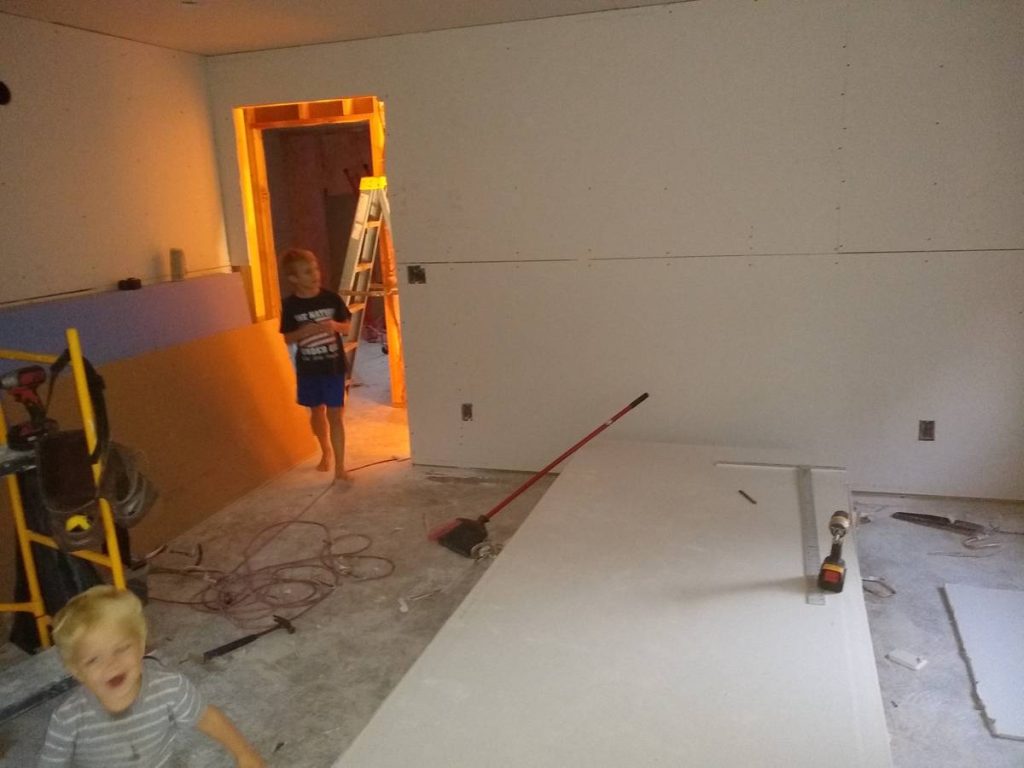
Except for the scrap pile. That pile started to grow and grow. I picked one of the back windows as the location for all the pieces of drywall that were not big enough to use. My sons discovered to their immense delight that a 5-inch wide strip of drywall is very easy to break with a karate chop. Or kick. Or a stick. Hatchet. Machete. Boys love demolition.
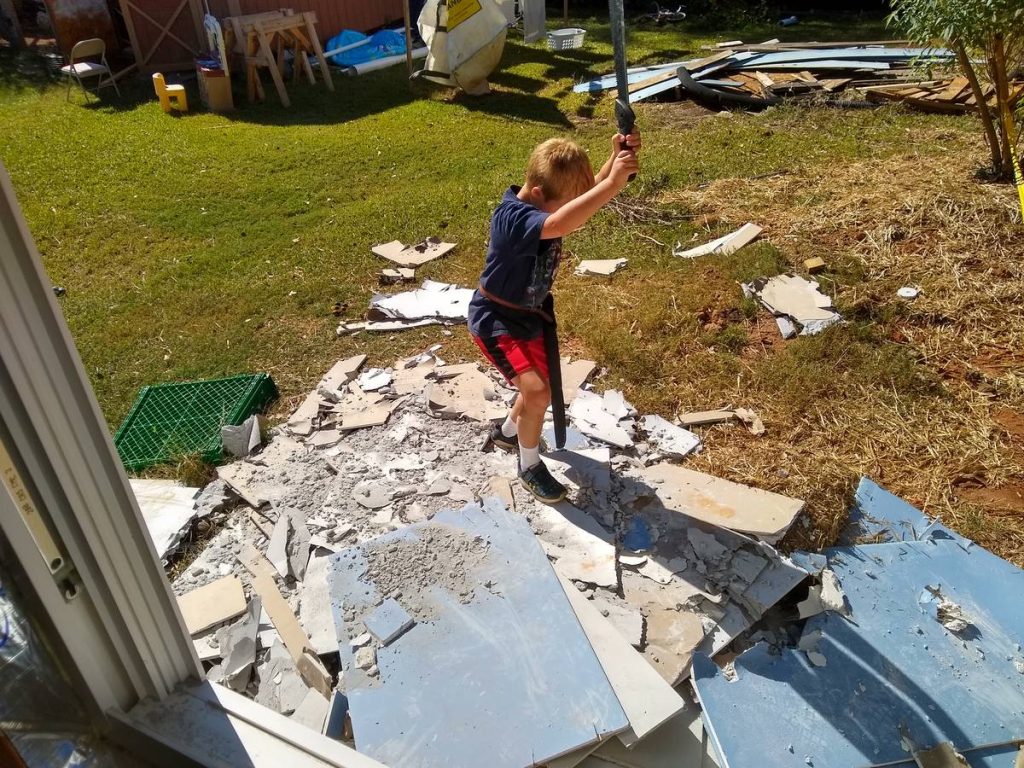
My buddy Ross came over for the final big piece of the drywall puzzle, which was installing the mini-split heads in each of the bedrooms. If you don’t know what I’m talking about, you’ve probably seen them. They are the little wall-mounted air-conditioning/heating units that hang from the walls and connect to a larger compressor outside. This took a couple of hours and a little bit of finagling because we had to push the copper refrigerant tubes up through the top plate of the wall and connect the drain lines to pipes we had already installed in the walls.
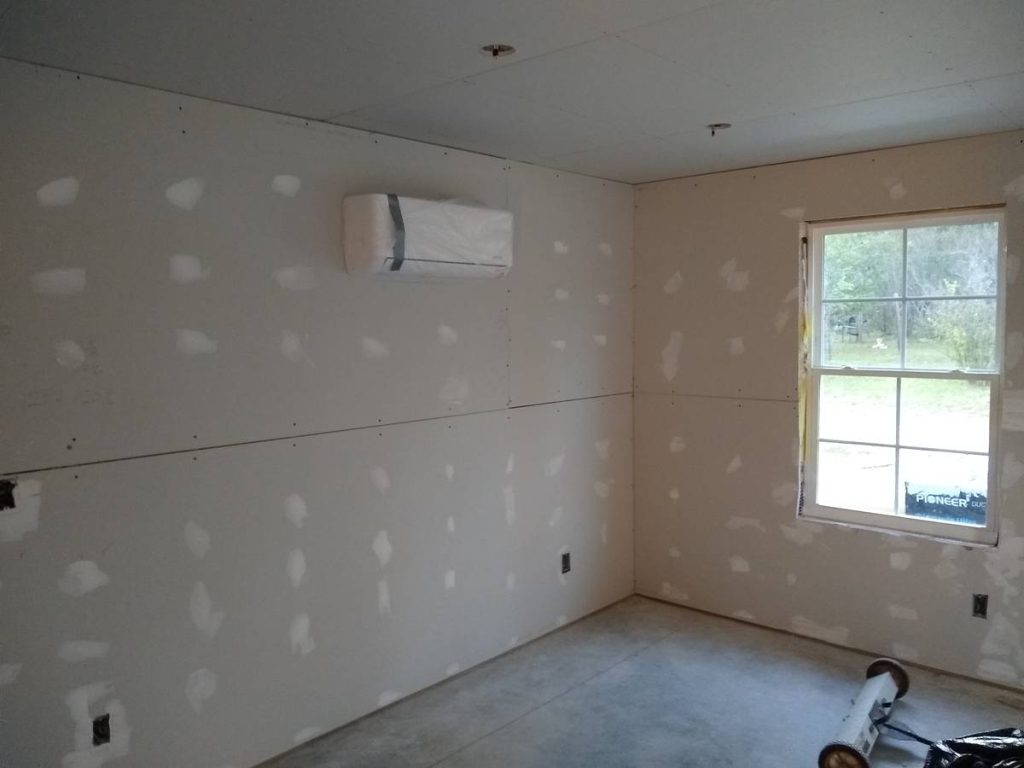
With that job accomplished, I finished up the last two closets and could celebrate the end of hanging drywall.
But wait, there’s more!
The next step in the process took almost as much time as hanging the drywall. Taping the drywall means putting drywall mud on the joints between sheets of drywall, putting tape on the mud, and smoothing out more mud on top of it. I used fiberglass tape that the mud could flow through instead of the paper tape that most professional drywallers use because it was more forgiving for a newbie like me.
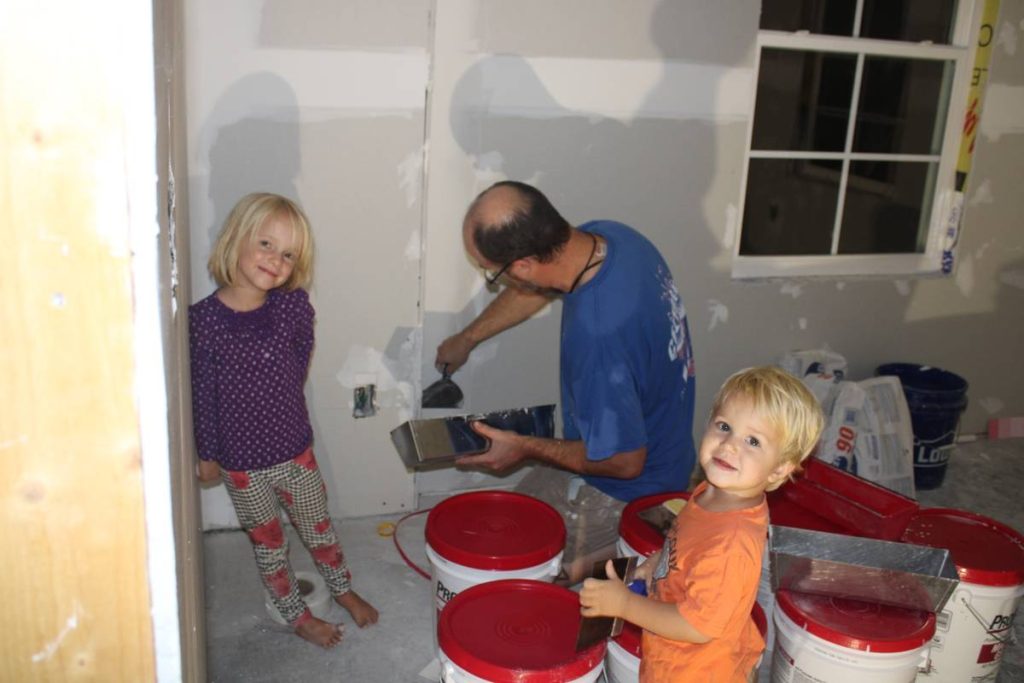
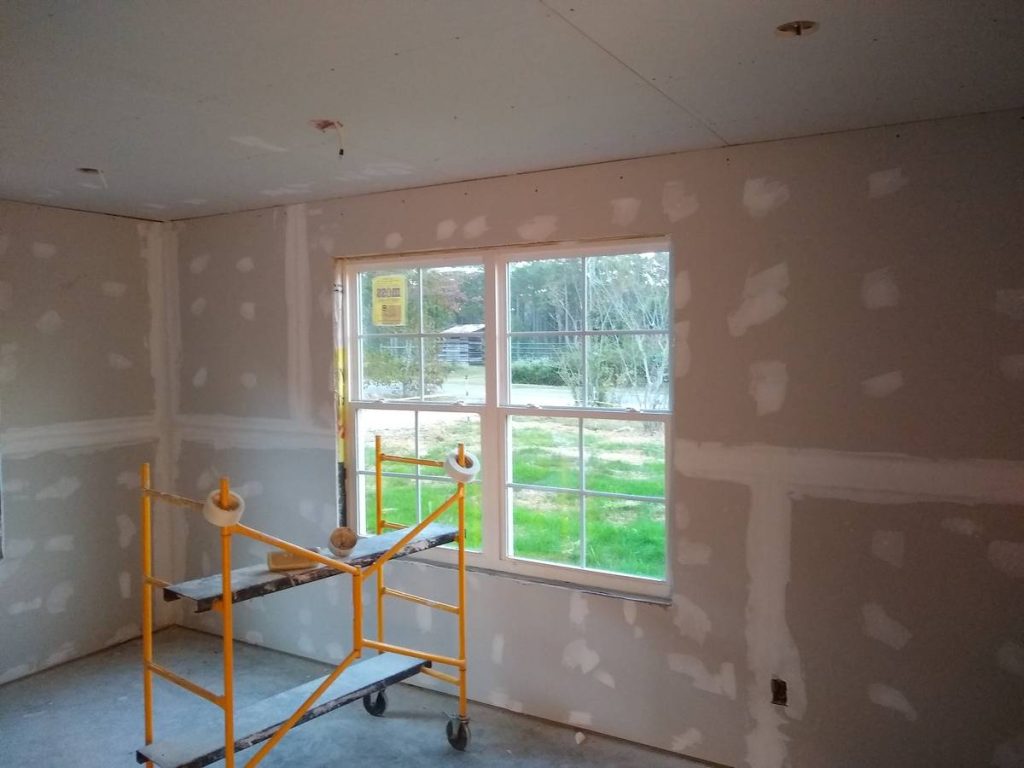
This is where I hit that marathon wall. It just kept going and going. Because it didn’t require power tools, I did it every night when the kids were asleep. So two or three hours a night were not uncommon. Night after night after night. And my joints looked terrible. I got really discouraged.
One day at work, I got completely overwhelmed. The discouragement and exhaustion just got too much for me. I was TIRED. And there was still so much left to do. The finish line felt farther away than when I started this project.
I stopped what I was doing and held my head in my hands. “God,” I prayed, “I need help. I need something. This is too much. I am totally overwhelmed. It feels like I’m never going to finish this project, and I’m already out of money, and it’s just not working. Please help me. I need something. Anything. Just a little encouragement. Please, Jesus, help me.”
I prayed like this for a few minutes and then sat in my chair quietly, waiting for God to answer. A memory came to mind, just a split-second flash. A couple of years ago, I had to rip out my entire living room floor when I put my foot through it where the Christmas tree was supposed to go. The memory that came to mind was the satisfaction that I felt after the project was done and I was sitting with my feet warming next to the wood stove and a cup of hot coffee in my hand.
Such a simple little memory, but that was exactly what I needed. This project is hard, but I’m going to get to the point where I’ll be able to sit back and enjoy the fruits of my labors. That’s all the encouragement I needed. A little light in the darkness goes a long ways.
Calling for help.
I also decided that the time had come to ask for help of a more practical kind. I told Larry that I thought that I should hire someone to finish the drywall after I did the taping and bedding coats. He immediately agreed and told me to call Frank Leogrande.
When Frank came over to look at the job, he had a very low-key manner. He told me that he started doing drywall in 1965. Or was it 1968. I don’t recall which exactly, but he’s been doing it at least 50 years. Frank is an master. He showed me how to properly bed the seams, which took him exactly 4 strokes of his mud knife. One to lay the mud, one to feather to the top, one to feather the bottom, and one to smooth it all out. It took me at least 30 strokes to make a seam about 25% the quality of what he showed me.
Frank agreed to come back and take over once I’d bedded all the joints. He understood both my financial constraints and my timeline, so that was the fastest, cheapest way to go.
I’d finished taping all the joints, and with Frank’s little lesson, I started bedding them. So time consuming. I would do two joints and realize that an hour had gone by. A person who did this for a living would be way faster than I was. But not cheaper.
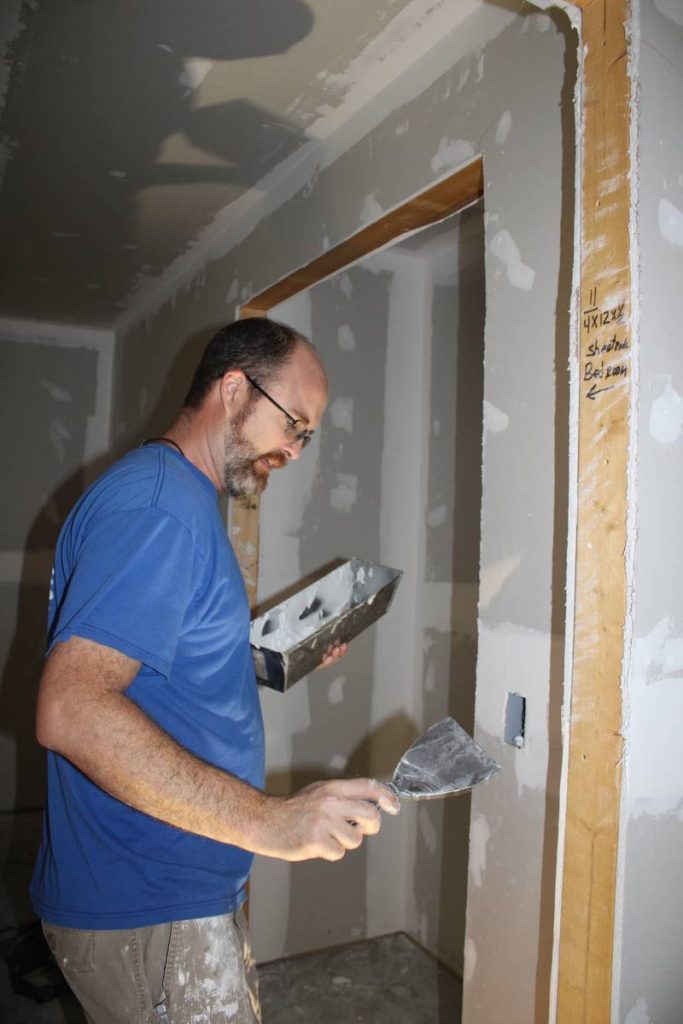
It’s amazing the difference a little bit of hope makes. Even though I knew that I was going to miss the deadline and the baby was going to arrive before I’d finished, I could keep going. I know that there will come a time that I’ll be able to rest and enjoy the home that I’ve built with my family and friends. That’s enough gas in the tank to get me over the finish line.
I wrapped up bedding all the joints about a week before the baby was due and called Frank to let him know that I was ready for him to come. He’s semi-retired, so he came a couple days later and started work finishing the drywall. He only worked for a couple of hours, but got an incredible amount done. One of his hours equals at least 20 of mine. Maybe 40.
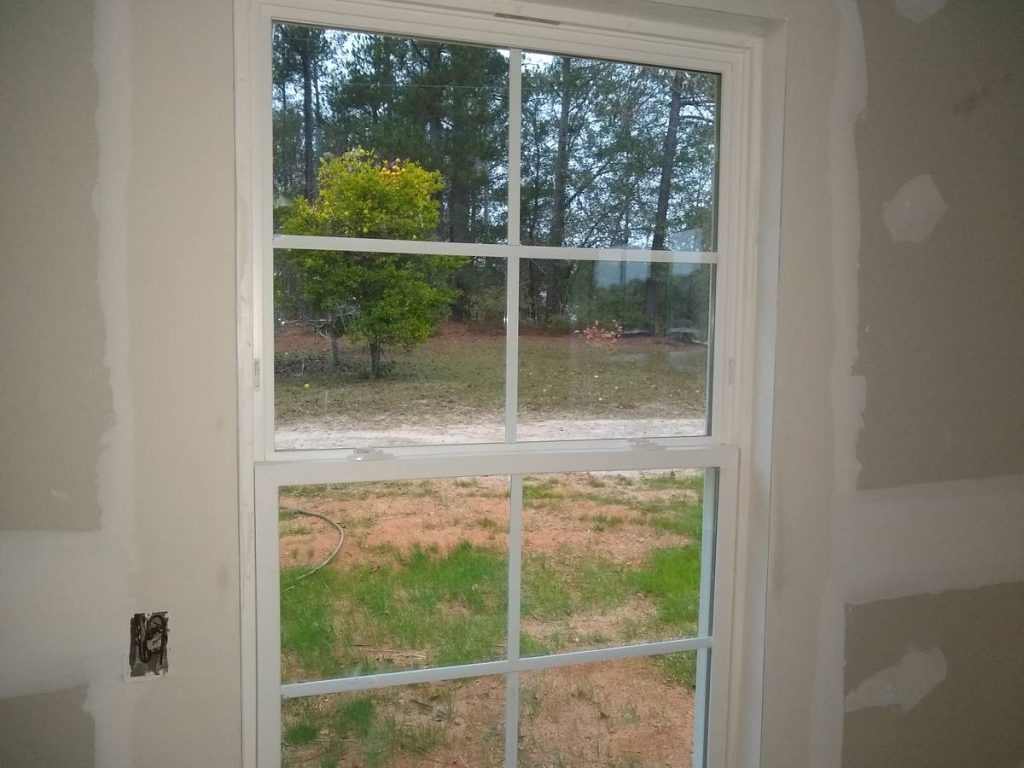
In the hands of a master.
A master like Frank can build on work done by a novice like me and make it look absolutely perfect. And with little or no apparent effort.
Walking through the addition and seeing the perfectly smooth seams reminded me of the book of Genesis. God formed Adam out of mud. He impressed His image and likeness on the mud and breathed into it to give it life.
God isn’t so much forming me as He is reforming me. Finishing me. Covering up the holes and filling in the gaps and smoothing out the rough spots. This level of detail work is way out of my league. I have to call on the Master daily and ask Him to come to my aid. And the amazing thing is that He responds so faithfully. He does it on His own time, but His timing is perfect.
When I reached the wall, when the darkness of discouragement became a stumbling block, He showed up with light. He IS the light. And He showed up.
Right now, I’m looking at my wife holding our new baby girl. They’re both snoozing. It’s such a beautiful image of the love that God has for us. He did not just create us and set us loose on the universe. He wants to hold us close, to nuture us, and walk with us through our difficulties. He gives us projects that are too big for us handle as an invitation to bring Him into the mix. He wants to walk with us and teach us to be more like Him. The sons and daughters of the living God, a loving Father.
Everyone’s generosity during this process has blown me away. The following people have helped to make this project a reality. I couldn’t have gotten this far without them: Mary Krupa, Larry Harris, David Jude Krupa, Joseph Krupa, Catherine Krupa, Jonathan Krupa, Jerry Germann, Joe Almeter, Nick Almeter, Lawrence Almeter, Michael Almeter (his son), Michael Almeter (his cousin), Tag Bussey, Leo Suer, Ben Suer, Matthew Suer, Pat Molitor, Tom Molitor, Hannes Molitor, Pat Muller, Nick Wingate, David Johnson, Jordan Goodman, David McGee, Glen and the guys at Maner, David Germann, Tom Krupa, Laura Krupa, Joseph Krupa, Joseph Muller, Philip Hatfield, Miguel Melendez, Maddox, Jared Miller, Fr. Jacob Almeter, Anthony Almeter, Bob Visintainer, Ross Ott, Noah Ott, Max Molitor, Peter Molitor, Mike Hayes, Gabriel Hays, Kolbe Almeter, Luke Almeter, Charlie Almeter, Eric Sterett, Gabriel Hayes, Wayne Johnson, Danny Johnson, Wes Swenson, Cohen Insulation, and Frank Leogrande.
If you don’t have time or tools to donate, but would like to help make the House of Krupa a reality, a financial gift would be a great blessing. This is kind of like a do-it-yourself GoFundMe. DIY is my style.
If you want to read more of my adventures building the House of Krupa, check out the archive!
Jesus snatched me out of the darkness and saved me from complete madness. If you want to hear more of that story, check out Demoniac, now available on Amazon.

